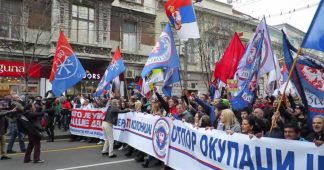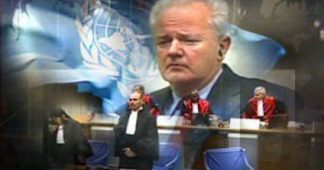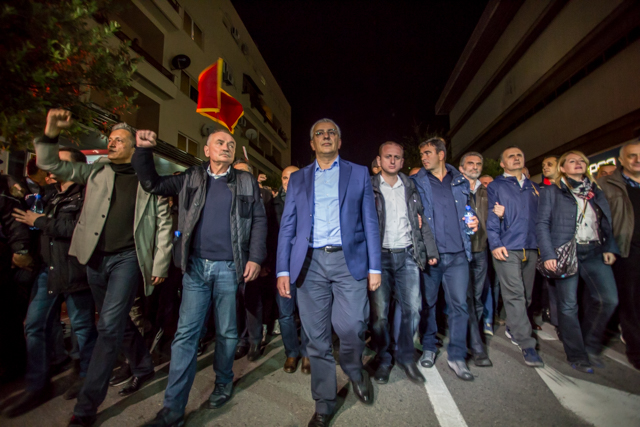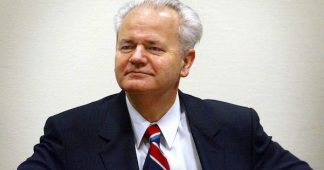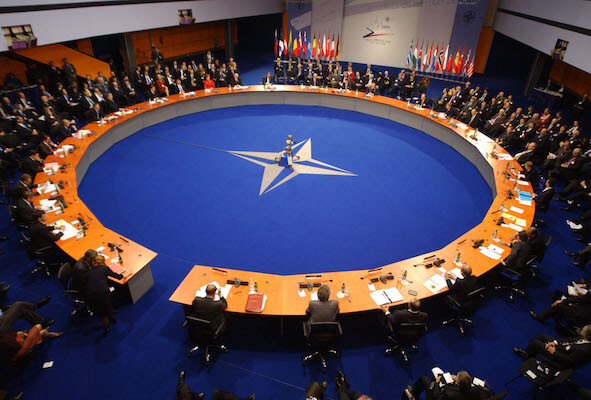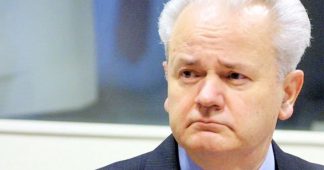By Joaquin Flores
The International Criminal Tribunal for the former Yugoslavia (ICTY) surprised many with its announcement of the verdict of the leader of the Serbian Radical Party Vojislav Seselj – he was acquitted of all charges, with the court finding no criminal wrong doing on his part. He was accused of financing, managing, and supporting the Serb volunteer units and inciting ethnic hatred during the wars in Croatia and Bosnia in the early 1990’s. His trial and imprisonment had long been a focus of Serbia’s heated internal political scene, which is split over the issue of European integration and NATO, or increased ties with the Eurasian Union and the CSTO. Seselj is seen as a symbol of Serbia’s resistance to foreign military and economic domination.
His acquittal comes as a surprise, not because of the strength of the evidence against him, but indeed the opposite. Previous convictions of other Serbs had been carried out by just as much evidence, which is to say, very little.
The trial of Vojislav Seselj
Unlike many of the others accused by the Hague Tribunal, Seselj did not hide from the court, but turned himself in to the Hague 10 days after the drawing up of the charges against him on 24 February 2004. Seselj wanted to defend his innocence in court and turn the trial into a trial against the Hague Tribunal. The prosecution lasted for 11 years and the Hague Tribunal has failed to provide conclusive evidence of Seselj’s guilt. In 2014, Seselj was freed for health reasons (cancer), but proceedings against him continued. Vojislav Seselj had no plans to attend today’s sentencing, as he believes that from a moral perspective he already defeated the Hague Tribunal a long time ago. Seselj’s defiance of the ICTY proceedings often took place at the proceedings themselves, and these now famous – intelligent and often humorous – indictments of the entire proceedings and indeed the entire Atlanticist legal order were recorded on film, having now become a component of popular Seselj lore and canon.
Intrigue and controversy behind his early release
His early release in November 2014 also came as a surprise, at a politically sensitive time in Serbia. Seselj had consistently maintained his innocence, and questioned the grounds of his arrest and the legitimacy of the entire procedure for the duration of his detention, pre-trial procedures, and trial. He voluntarily surrendered in 2004, and used his platform not only to prove effectively that the charges against him were false, but to ridicule and mock the criminality and incompetence of the court itself.
The best theory behind his early release relates to Russia and the ongoing conflicts in the world which involve both the US and Russia at seemingly opposite ends, as well as the Color Revolution/Spring tactic. It is clear that the US has the most clout over the proceedings of the ICTY, as the court itself is widely viewed as a kangaroo court where the prosecution and the judges work on the same side, to arrive at a politically pre-determined verdict, on the foundation of victor’s justice. Both the US and Russia see Seselj as a potential game changer for Serbian politics, but have opposing goals in mind.
Both players understand that the actions of Seselj will figure into the stability and legitimacy of the present Serbian government of the Progressive Party. We must recall that the role of Russian doctors claiming an illness is not new; this was used with Milosevic’s case, in failed attempts to have him released from prison due to his illness. There then came some coherent evidence that Milosevic’s early death was brought about directly by the ICTY or its handlers, as Milosevic’s defense strategy was prevailing over the kangaroo court at the Hague, even with all mechanisms stacked in its own favor.
There is little reason to conclude that the US would have agreed to the release of Seselj if it was not part of some compromise or deal with the Russians, who provided both the diplomatic framework and medical justifications for his early release in November 2014. That means that to understand this, we cannot compartmentalize this case, and instead look at this as part of a larger global conflict, which involves live-fire conflicts in Ukraine and Syria.
Seselj’s release in November can then be seen as part of a larger negotiation connected with ceasefires or prisoner exchanges, but also in the context of any aim to destabilize Serbia.
But it would also be an error to view this entirely in terms of Russians having some interest in his release, with the Americans entirely wanting him to be imprisoned. Rather, the US also had an angle in releasing Seselj. What was it?
The US and Russia both wanted Seselj released
Vucic is sitting in two chairs, and finds himself in a unique situation, but one similar to both Yanukovych of Ukraine and Assad of Syria. The facts and circumstances which have emerged tend strongly to confirm the view that Vucic is no longer seen by the West as someone who can remain at the head of the government. Despite his gestures, which are fiercely opposed by the fractured nationalist and patriotic bloc, he has not made significant progress in reducing Serbia’s sovereignty in a number of key areas such as NATO and the EU. Furthermore, as the US has decided to move into a failed state model for the 2nd world countries of certain regions, it is likely that the West Balkans is such a region, for reasons relating both to Serbia’s strategic culture and Serbia’s strategic use of culture, energy markets, and geopolitical alliances.
Stability and prosperity for certain regions do not fit into the US grand-strategy, and the US seeks a relative advantage by setting back others in areas where they found themselves unable to get ahead. This is difficult for many Serbians to understand, because Vucic has long been vilified for his attempts at being in the good graces of the West.
It was hoped by the Atlanticist powers behind Seselj’s early release that he would immediately engage in the politics he has been known for: resounding attacks against a corrupt and entrenched political establishment led by Prime Minister Vucic, which he views as bent on undermining the sovereignty and security of Serbia. Instead, Seselj frustrated them, and has refrained from attacking Vucic, who many see as farther from Seselj politically, and contrary to this did two things, which seem contradictory and frustrated the Atlanticist plot. He began attacking Serbia’s now deposed political establishment of the Democratic Party, which is viewed by nearly everyone as being closer to the West than Vucic, even if by a degree or two. At the same time he did something entirely at odds with that – in attacking President Nikolic, who is nevertheless viewed by the public as being closer politically, even if by a degree, both to Seselj and to Russia.
The US is attempting to forge a liberal + nationalist alliance in Serbia, a standard practice for them in the Color/Spring tactic. The details vary in each country, based on profound differences rooted in culture, politics, and history. In Ukraine, nationalists were anti-Russian and saw themselves as a continuation of European identity, even where at times this clashed with Europe’s new liberal self-conception and instead relied on older continental incarnations of European power such as the Third Reich. In Serbia it is quite different, nationalists are pro-Russian and specifically anti-EU and anti-NATO. Furthermore, Serbia has already experienced a decidedly pro-Western coup in the past, using the Color/Spring tactic. This means that any tactic, applied again to Serbia, must take into account and figure around those points which Serbians may already be inoculated against.
The credibility of Seselj and the Serbian nationalist’s reverence for him was sought by the Atlanticists to be used as a tool against the government of Vucic.
One of the main operating and proven ideas is that vague or open ended political slogans can be co-opted for any purpose by those with better power at projecting their message, and connecting the dots for the masses. In other words, without tremendous media power, one cannot control the consequences of their own statements if vague or when made with provisos, which part of that statement would be redacted, or conversely which part highlighted and echoed, and so on.
Any vague ‘anti-Vucic’ remarks that Seselj was encouraged to make, can then have its conclusions drawn out and solutions created by other nationalist leaders with Western backing.
The Russians on the other hand were several moves ahead on this play. They saw that while Seselj’s release would invigorate Serbian nationalism, that this could easily and most naturally be directed towards its own aims, with a much less convoluted plot when compared to the American. Instead, Seselj was advised, or naturally intuited based on his own knowledge of realpolitik, to attack the liberals (in power for the decade following the bombing of Belgrade) and Nikolic, the current president. This clearly gave Vucic a pass, who in response elevated Seselj somewhat officially to that of the ‘Third force’ in Serbian politics.
Why Vucic must go
Presently the government of Serbia is trying to conduct its most balanced foreign policy since the Yugoslavia period. This means that it conducts diplomacy and international dealings in a way that reflects the realities of Russia’s resurgence as well as the EU’s prominent though waning economic clout, combined with US military superiority in the Balkans through NATO, including Camp Bondsteel in the occupied Kosovo region of Serbia.
This attempt at a balanced policy creates political problems at home, with US and EU backed liberals – a minority numerically but with ties to finance, media, and light industry – seeing the Progressive Party government of Vucic as swerving dangerously off track from EU ascension, and wary of the government’s economic deals with China, Russia, and the increasing Russian presence in Serbia’s deep state, security apparatus, military agreements, observer status in CSTO, Serbia’s refusal to play the sanctions game against Russia, and the general refusal to engage in the US dominated political narrative of ‘isolated Russia’.
Serbian patriots, that is ‘nationalists’, on the other hand, have an opposite view. They see Vucic’s conciliatory tone on subjects like Kosovo, attempts to woo foreign EU investment, as well as his statements and official policy of EU integration (though in fact there has been little if any forward movement), as well as making a passage and tax deal that favors NATO’s presence, as evidence that he is against Serbia’s sovereignty and is actively working with Serbia’s moral and geostrategic opponents.
The Serbian patriotic scene readily, and rightly, embraced both Assad of Syria and Gaddafi of Libya, and supported their resistance to the Color/Spring tactic, and understood it in such terms. What was absent from their collective analysis, or rather, what has failed to be underscored as it relates to Serbia, is that Vucic is in a similar situation in certain important aspects, as was Yanukovych or Assad. In the case of Assad – there were, at the beginning, very real ‘pro-Syrian’ objections to Assad’s governance, primarily rooted in the concessions and relationship that he built with western powers in the years directly following the US invasion of Iraq.
Not only since the collapse of the USSR, but more so after the US’s middle-east incursions, Syria sought branding as one of the ‘moderate’ countries in the region, which agreed to social and economic reforms in Syria, bringing in further IMF debt and forfeiting important social-government work to foreign controlled NGO’s, who eventually won the hearts and minds of a sizable minority of the country’s population, leading to the formation of the coalition and the FSA.
It has been a failure on the part of Serbians to understand that prior to being scheduled for offing, Assad had attempted to maintain balanced relations with Russia, China, and Iran on the one hand, and Turkey, the EU, the US and other players on the other. While Vucic has committed to policies which critics are right to point out, the alternative supported by the west involving his removal would result in not only an end to the Progressive Party government, but to the Serbian state itself.
This last part is critical: Serbia is in a delicate position where it has the possibility of either gaining Republika Srpska and regaining Kosovo, while maintaining regions like Vojvodina, or by fracturing and shattering further, as part of a precursor to an actual conflict between devolving local powers and hostile regional states.
Seselj refused to play a role in the Color/Spring script
The Color/Spring tactic is an active and adaptive method. The organizations which move it are capable of self-awareness, meaning they are aware that there are active attempts to subvert or derail the tactic, and the tactic adapts to this threat as a living or sentient entity would. This means that the tactic has undergone several evolutions since it was first introduced many decades ago during the Cold War, to the point where it can even adapt to political mechanisms and movements (such as in Serbia) that are aware of its methods and tactics and have therefore built some level of immunity to it.
That means that instead of using the public’s relatively non-existent pro-Western and anti-Russian sentiments towards a catalyzed ‘Majdan’-like spring/occupy/color tactic, another track is being taken. The idea for Serbia is to attack Vucic for his inability to make a coherent and uniform pro-Russian policy. The result of the attack is his desired downfall, and his replacement by an actually anti-Russian government, with the possibility of the dismantling of the state both in terms of territory and the military-security apparatus.
Because Seselj apparently understood the plot that he was expected to play a part in, and saw the trap, he was able to avoid it. This caused the ICTY to call for his return, something which the government of Serbia was wise to gesture their unwillingness to cooperate with. Had they returned him, it would have meant the creation of an occupy/spring tent encampment at the steps of government offices, with the call for Vucic to step down.
For these reasons, today’s acquittal of Seselj is both a surprise and, just as his conviction would have been, a political maneuver on the part of the ICTY and its NATO backers, which analysts will be attempting to reconcile and explain in the coming period.
The best theory so far is this: Seeing that Vucic would not hand Seselj back months ago after the urging of the ICTY and complaints by Croatia, and would not even send him for today’s verdict, the West would not further their position by convicting Seselj. In fact, Vucic’s refusal to hand Seselj back after such a conviction would further bolster his credibility in the eyes of the fractured nationalist bloc, and would work against the West’s aims to undermine his authority, and the project to remove Vucic from power through some popular protest-type movement, connected to next month’s elections in Belgrade. By simply acquitting Seselj, Vucic cannot demonstrate his fealty to the Serbian cause by refusing to hand him over. Vucic has been robbed of this opportunity, even though it provides Seselj the legal guarantees required to position himself as a viable alternative candidate for the remainder of his career.
